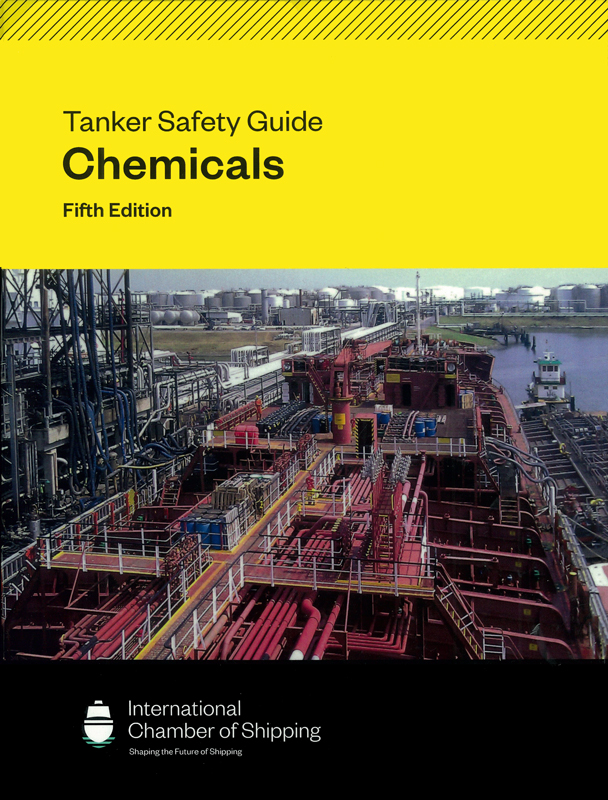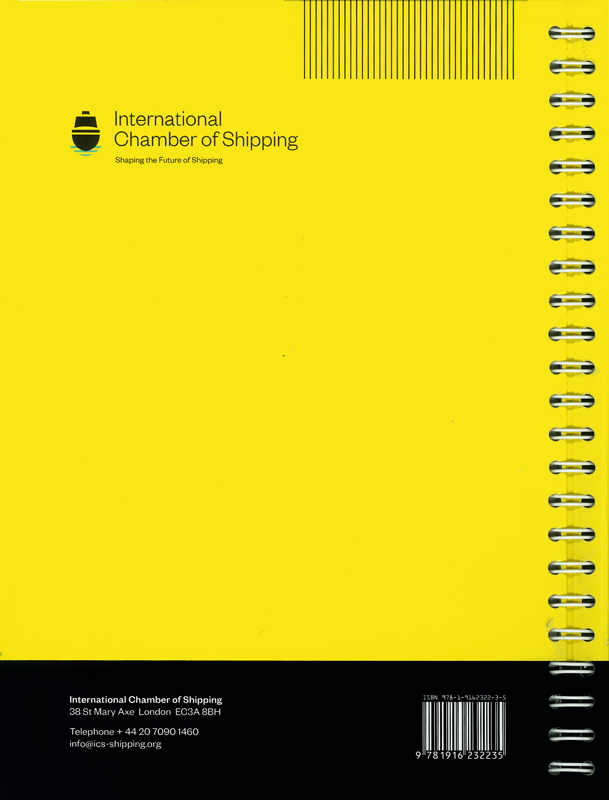Tankers Safety Guide (Chemicals). Руководство по безопасности танкеров (химикаты)
Мы не можем гарантировать его наличие и поступление на наш склад по указанной цене
Издание на английском языке.
Now in its fifth edition, the Guide provides chemical tanker operators and crew with up-to-date best practice guidance for safe and pollution-free operations on ships regulated under MARPOL Annex II (Regulations for the Prevention of Pollution by Noxious Liquid Substances).
Contents
Abbreviations
Definitions
Chapter 1 Hazards and Properties of Chemicals
1.1 Introduction
1.2 Physical Properties
1.2.1 Specific gravity and density
1.2.2 Volume expansion coefficient
1.2.3 Melting/freezing point
1.2.4 Vapour pressure
1.2.5 Boiling point
1.2.6 Vapour density
1.2.7 Viscosity
1.2.8 Water solubility
1.3 Flammability
1.3.1 Flashpoint
1.3.2 Explosive/flammable limits
1.3.3 The effect of inert gas on flammability
1.4 Static Electricity
1.4.1 General
1.4.2 Charge accumulation and relaxation in liquids
1.4.3 Generation of static
1.4.4 Static generation during cargo operations
1.4.5 Static generation during tank cleaning
1.4.6 Static generating portable equipment
1.5 Toxicity
1.5.1 General
1.5.2 Exposure to toxicity
1.5.3 Degrees of toxicity
1.5.4 Exposure limits
1.5.5 Precautionary principles
1.6 Reactivity
1.6.1 General
1.6.2 Unstable chemicals
1.6.3 Chemicals that react with oxygen
1.6.4 Chemicals that react with water
1.6.5 Reaction of acids with water
1.6.6 Incompatible chemicals
1.6.7 Reaction with construction materials
1.7 Corrosive Substances
1.7.1 General
1.7.2 IBC Code requirements
1.8 Hazardous Cargo Information
1.8.1 Safety data sheet
1.8.2 Contents of an SDS
Chapter 2 General Precautions
2.1 Introduction
2.2 Moorings
2.3 Emergency Towing-off Pennants (Fire Wires)
2.4 Access to the Ship
2.4.1 Means of access (gangways or accommodation ladders)
2.4.2 Lighting
2.4.3 Unauthorised access
2.4.4 People smoking or intoxicated
2.5 Warning Notices
2.5.1 Permanent
2.5.2 Temporary
2.6 Effects of Other Ships and Berths
2.6.1 Other tankers at adjacent berths
2.6.2 Chemical carrier operations at general cargo berths
2.7 Weather Precautions
2.7.1 Wind conditions
2.7.2 Electrical storms
2.7.3 Cold weather
2.7.4 Openings to the accommodation
2.7.5 Accommodation atmosphere control
2.8 Machinery Spaces
2.8.1 Funnel sources of ignition
2.8.2 Blowing boiler tubes
2.8.3 Cargo vapour
2.9 Pressure Surges
2.9.1 Introduction
2.9.2 Generation of pressure surge
2.10 Pumprooms and Enclosed Spaces
2.10.1 Cargo pumprooms
2.10.2 Enclosed spaces
2.11 Ship’s Readiness to Move
2.12 Helicopter Operations
2.13 Communication Equipment
2.13.1 Ship’s radio transmission equipment
2.13.2 Electrical maintenance and repairs
2.13.3 Transmitting devices
2.13.4 Personal electronic items
2.14 Hot Work
2.14.1 General
2.14.2 Assessment of hot work
2.14.3 Hot work permit
2.14.4 Preparation for hot work
2.14.5 Checks by officer responsible for safety during hot work
2.14.6 Action on completion of hot work
2.14.7 Hot work flowchart
2.15 Cold Work
2.16 Mechanically Powered Tools
2.17 Hand Tools
Chapter 3 Safety Management, Training and PPE
3.1 Introduction
3.2 Implementing a Safety Culture
3.2.1 What is a safety culture?
3.2.2 Key features of an effective safety culture
3.3 The ISM Code
3.4 Company Responsibility
3.5 Safety Information for Shore Personnel
3.6 Outside Contractors
3.7 Risk Assessments
3.7.1 Risk assessment process
3.7.2 High risk activities and permits to work
3.7.3 Acceptable risk
3.7.4 Risk matrices
3.7.5 Determining the need for a risk assessment
3.7.6 Generic and task based risk assessments
3.7.7 Competence for carrying out risk assessments
3.8 Safe Operations
3.8.1 Routine operations
3.8.2 Non-routine operations
3.9 Incident Investigations
3.10 Crew Resources
3.10.1 Training
3.10.2 Familiarisation
3.10.3 Drills and exercises
3.10.4 Crew communication
3.10.5 Shipboard working arrangements and hours of work/rest
3.10.6 Prevention of drug and alcohol abuse
3.11 Personal Protective Equipment (PPE)
3.11.1 General
3.11.2 Safe working clothing
3.11.3 Protective clothing
3.11.4 Toxic or corrosive substance protection
3.11.5 Chemical-resistant clothing (protective suits)
3.11.6 Types of chemical-resistant clothing
3.11.7 Eye protection
3.11.8 Hand protection
3.11.9 Foot protection
3.11.10 Cargo-specific PPE
3.11.11 Respiratory protection
3.11.12 Self-contained breathing apparatus
3.11.13 Air-line breathing apparatus
3.11.14 Emergency escape respiratory protection
3.11.15 Canister or filter-type respirators
3.11.16 Maintenance
3.11.17 Training
Chapter 4 Regulatory Framework
4.1 Introduction
4.2 Regulatory Guidelines
4.3 IMO MARPOL Regulations
4.3.1 MARPOL Annex I - Prevention of Pollution by Oil
4.3.2 MARPOL Annex II - Prevention of Pollution by Noxious Liquid Substances
4.3.3 MARPOL Annex VI - Prevention of Air Pollution from Ships
4.4 IMO International Code for the Construction and Equipment of Ships Carrying Dangerous Chemicals in Bulk (IBC Code)
4.4.1 Tank types
4.4.2 Summary of IBC Code requirements
4.4.3 Vapour space environment control
4.4.4 Damage stability
4.5 Inert Gas Requirements for Chemical Carriers
4.6 IMO Ballast Water Convention
Chapter 5 Ship and Equipment
5.1 Introduction
5.2 Cargo Tanks
5.3 Monitoring Equipment
5.3.1 Introduction
5.3.2 Alarms and shutdowns
5.3.3 Air supply to control systems
5.3.4 Liquid level gauges
5.3.5 Overfill detection systems
5.3.6 Pressure indicating devices
5.3.7 Temperature monitoring equipment
5.4 Atmosphere Monitoring
5.4.1 General
5.4.2 General precautions
5.4.3 Oxygen analysers
5.4.4 Flammable gas detectors
5.4.5 Toxic gas detectors
5.4.6 Hydrogen sulphide (H2S)
5.5 Cargo Pumps
5.5.1 General
5.5.2 Deepwell pumps
5.5.3 Cargo pumprooms
5.5.4 Booster pumps
5.5.5 Emergency cargo pumps
5.6 Piping Systems and Valves
5.7 Cargo Manifold
5.8 Venting Systems and P/V Valves
5.9 Vapour Return Systems
5.10 Heating and Cooling Systems
5.10.1 Heating coils
5.10.2 Heat exchangers
5.10.3 Heating medium
5.10.4 Heating of toxic products
5.10.5 Cooling systems
5.11 Tank Washing Systems
5.11.1 Fixed tank washing machines
5.11.2 Portable tank washing machines and hoses
5.12 Gas Freeing Equipment
5.12.1 Permanently installed gas freeing equipment
5.12.2 Portable gas freeing equipment
5.12.3 Venting outlets
5.13 Inert Gas Systems
5.13.1 Introduction
5.13.2 Oxygen content
5.13.3 Sources of inert gas
5.13.4 Compressed nitrogen stored on board
5.13.5 Liquid nitrogen stored on board
5.13.6 Pressure swing adsorption nitrogen generators
5.13.7 Membrane separation nitrogen generators
5.13.8 Oil-fired inert gas generators
5.14 Cargo Hoses
5.14.1 Introduction
5.14.2 Types of cargo hose
5.14.3 Certification, marking and testing
5.14.4 Storage and maintenance
5.14.5 Operational use
5.14.6 Cargo hose connections
5.14.7 Electrical continuity testing
5.15 Electrical Equipment and Installations in Hazardous Areas
5.15.1 Introduction
5.15.2 Certified safe electrical equipment
5.15.3 Bonding and earthing
5.16 Ballast Pumprooms
5.17 Openings in Deckhuses and Superstructures
Chapter 6 Cargo Operations
6.1 Introduction
6.2 Responsibility
6.2.1 Personnel and resources
6.3 Planning Cargo Operations
6.3.1 Introduction
6.3.2 Cargo information
6.3.3 IMO certificate of fitness
6.3.4 Stowage planning
6.3.5 Specific cargo handling requirements
6.4 Preparation for Cargo Operations
6.4.1 Introduction
6.4.2 Pre-arrival information exchange
6.4.3 Cargo handling plan
6.4.4 Ship’s personnel
6.4.5 Preparing the cargo system prior to arrival
6.5 Port Arrival Procedures
6.5.1 Pre-transfer conference
6.5.2 Ship/shore communications during cargo operations
6.5.3 Ship/shore safety checklist
6.5.4 Action prior to commencing transfer operations
6.6 Monitoring Cargo Operations
6.7 Cargo Transfer Operations
6.7.1 Inspection of cargo tanks prior to loading
6.7.2 Manifold connections
6.7.3 Cargo loading
6.7.4 Ship/shore electric currents
6.7.5 Cargo pumprooms
6.7.6 Correct operation of P/V valves
6.7.7 Vapour return and vapour balancing
6.7.8 Tank atmosphere control
6.7.9 Dangers of pressurised loading
6.7.10 Topping off procedure
6.7.11 Sampling
6.7.12 Sample management
6.7.13 Sampling systems
6.7.14 Sample storage
6.7.15 Ballasting and deballasting in port
6.7.16 Clearing shore pipelines
6.7.17 Completion of transfer
6.7.18 Disconnection of cargo hoses
6.7.19 Cargo discharging
6.7.20 Inerting and tank atmosphere control during discharging
6.7.21 Sweeping of cargo residues
6.7.22 Completion of discharge
6.8 Cargo Care During the Voyage
6.8.1 Tank integrity
6.8.2 Tank venting
6.8.3 Temperature-controlled cargoes
6.8.4 Inhibited cargoes
6.8.5 Maintaining an inert atmosphere during the voyage
6.8.6 Ballasting cargo tanks
6.9 Ship-to-Ship Transfer
6.9.1 General
6.9.2 Responsibility
6.9.3 Communications
6.9.4 Navigational warnings
6.9.5 Weather conditions and limitations
6.9.6 Pre-transfer preparations on each ship
6.9.7 Cargo transfer operations
6.9.8 Completion of cargo transfer
Chapter 7 Inert Gas and Nitrogen Safety
7.1 Introduction
7.2 Dangers of Nitrogen
7.3 Safe Operations Involving Nitrogen
7.4 Inerting Operations
7.4.1 Inerting definitions
7.4.2 Maintenance of an inert atmosphere
7.4.3 Inerting tanks containing cargo
7.4.4 Inerting empty tanks
7.4.5 Loading inerted tanks
7.4.6 Maintaining inerted tanks during the voyage
7.4.7 Maintaining an inert atmosphere during discharging
7.4.8 Tank cleaning and gas freeing under inert conditions
7.4.9 Nitrogen supplied from shore
Chapter 8 Tank Cleaning and Gas Freeing
8.1 Introduction
8.2 Procedures and Arrangements Manual
8.3 Supervision and Preparation
8.3.1 Responsibility
8.3.2 Tank cleaning plan
8.3.3 Pre-cleaning meeting
8.3.4 Preparations
8.4 Cargo Tank Washing and Cleaning
8.4.1 General
8.4.2 Tank washing atmospheres
8.4.3 Prevention of toxic exposure during tank cleaning
8.4.4 Prevention of static generation during tank cleaning
8.4.5 Tank washing in an inert atmosphere
8.4.6 Tank washing in a non-inert atmosphere
8.5 Special Cleaning Methods
8.5.1 Introduction
8.5.2 Reactive cargoes
8.5.3 Manual cleaning
8.5.4 Use of tank cleaning additives
8.5.5 Steaming
8.5.6 Recirculation washing
8.5.7 Cleaning or gas freeing of cargo from non-cargo spaces
8.6 Monitoring Tank Cleaning Operations
8.6.1 Precautions for sounding tanks when not using a sounding pipe
8.7 Arrangements for the Disposal of Tank Washings and Slops
8.7.1 General
8.7.2 Management of slops
8.7.3 Mandatory prewash water
8.8 Tank Cleaning in Port
8.9 Tank Cleaning Equipment
8.10 Ventilation of Cargo Residues
8.11 Gas Freeing
8.11.1 Safe procedures for gas freeing after tank cleaning and cleaning by ventilation.
8.11.2 Opening up cargo lines and handling equipment
Chapter 9 Entry into Enclosed Spaces
9.1 Introduction
9.1.1 IMO guidelines
9.2 Hazards
9.2.1 Oxygen content in air
9.2.2 Oxygen deficiency
9.2.3 Toxic and/or flammable gases
9.2.4 Presence of inert gas, including nitrogen
9.2.5 Oxygen enrichment
9.3 Atmosphere in Enclosed Spaces
9.3.1 Entry precautions
9.4 Requirements for Enclosed Space Entry
9.4.1 Planning
9.4.2 Enclosed space entry permit
9.5 Testing before Entry
9.5.1 Testing for entry in shipyards
9.6 Enclosed Space Entry
9.6.1 Entry into cargo tanks
9.6.2 Entry into enclosed spaces other than cargo tanks
9.7 Work in Enclosed Spaces
9.8 Entry into an Enclosed Space where the Atmosphere is Known or Suspected to be Unsafe
9.9 Rescue from Cargo Tanks and Other Enclosed Spaces
9.9.1 General
9.9.2 Rescue and recovery organisation
9.9.3 The rescue operation
9.9.4 Rescue and recovery equipment
9.10 Atmosphere Monitoring of Deck Areas
10 Emergency Procedures
10.1 Introduction
10.2 Emergency Organisation
10.2.1 Emergency/rescue team
10.2.2 Supporting crew
10.2.3 Emergency organisation in port
10.2.4 Vacating a berth or terminal in an emergency
10.3 Firefighting Equipment
10.3.1 General
10.3.2 Fire control plans
10.3.3 International shore fire connection
10.3.4 Water
10.3.5 Foam
10.3.6 Foam monitors
10.3.7 Carbon dioxide
10.3.8 Halon
10.3.9 Dry powder
10.3.10 Inert gas systems
10.3.11 Firefighting clothing
10.4 Responding to Emergencies
10.4.1 Emergencies involving fire
10.4.2 Emergency response to fire
10.4.3 Fires involving chemicals
10.4.4 Action to take in the event of a fire
10.5 Other Emergencies
10.5.1 Chemical cargo spills
10.5.2 Deck valve and deck pipeline leaks
10.5.3 Tank leaks within the ship
10.5.4 Emergency discharge or jettison of cargo
10.6 Notification of Spillage
10.7 Exposure to Chemicals
10.7.1 Planning
10.7.2 Medical first aid guides
10.7.3 Toxic cargoes and antidotes
10.7.4 Medical first aid after exposure to chemicals
10.7.5 Emergency information on SDS
10.8 First Aid and Further Care
Appendices
Appendix A - Visitor Information Card
Appendix В - Ship/Shore Safety Checklist
Appendix C - Safety Data Sheet (SDS)
Appendix D - Certificate of Protection
Appendix E - Enclosed Space Entry Permit
Appendix F - PPE Matrix
Appendix G - Relevant Industry Publications



